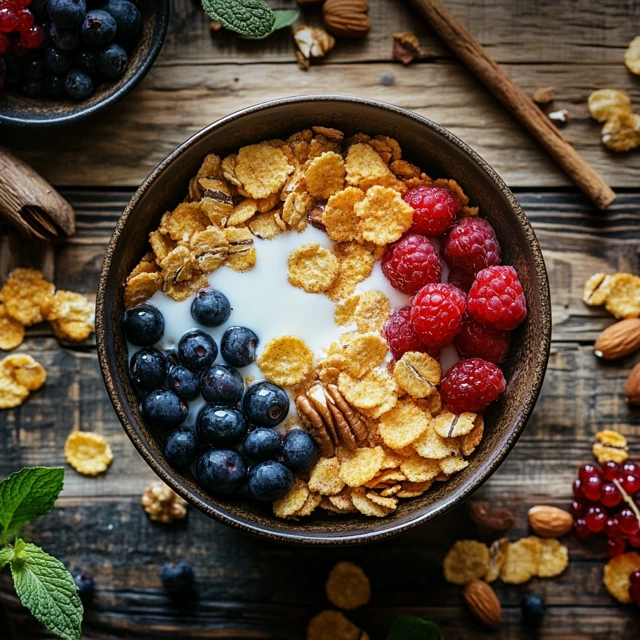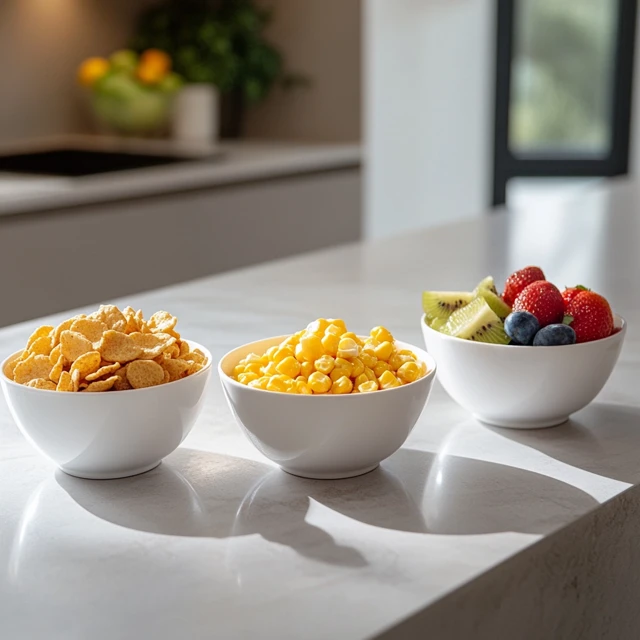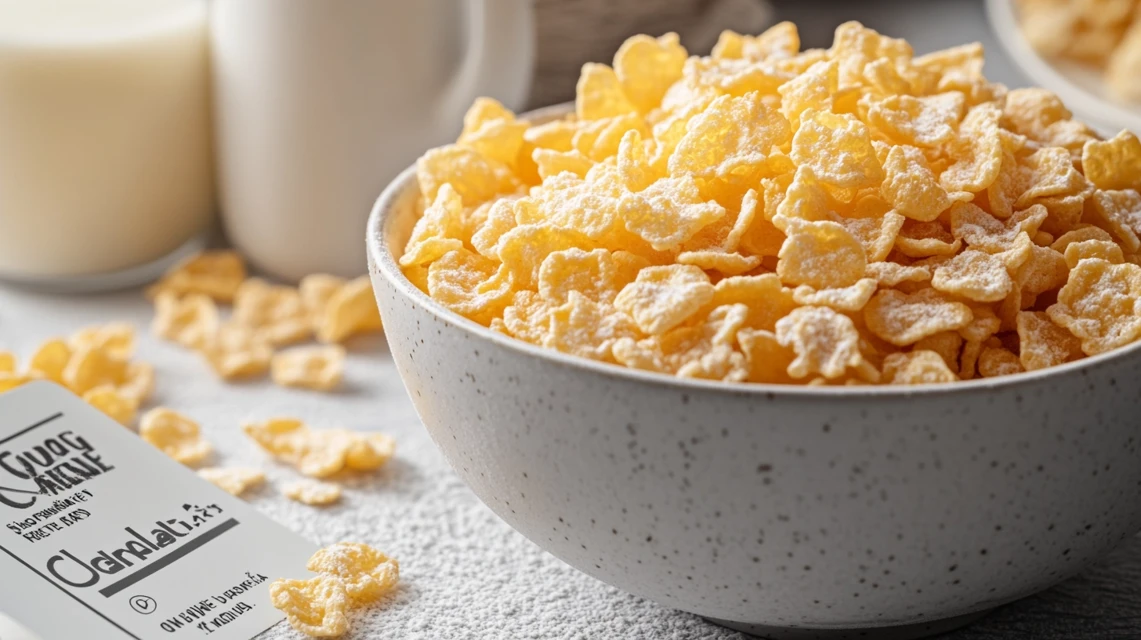When you’re picking out breakfast cereal, you probably wonder about sugar. Sure, corn flakes might look like a healthy choice, but we need to look closer at how much sugar is really in them. First, let’s talk about what affects the sugar in your bowl of corn flakes. Plus, there are some things you should know that can change how much sugar you end up eating.
Understanding Sugar Content in Corn Flakes
To truly understand the sugar content in corn flakes, we need to explore how much sugar is typically present in this breakfast staple and how it compares to other cereals.
check out this https://eassyrecipes.com/category/breakfast/
Average Sugar Levels in Corn Flakes
On average, a standard serving size of corn flakes—about 1 cup or 30 grams—contains 2-3 grams of sugar. This makes them relatively low in sugar compared to other breakfast cereals. However, the actual sugar content can vary depending on the brand and any added sweeteners used during production.
For instance:
- Plain corn flakes: Generally contain the lowest amount of sugar, around 2 grams per serving.
- Sweetened or flavored varieties: Can contain anywhere from 6 to 12 grams of sugar per serving, depending on the added ingredients.
This variability means it’s crucial to read nutritional labels before making a choice.
check out this https://eassyrecipes.com/category/breakfast/
How Serving Sizes Affect Sugar Content
How Much Sugar Is In A Bowl Of Cornflakes? This really depends on how much you pour! While you should eat 30 grams of corn flakes in one serving, many people fill their bowls with much more without knowing it. So here’s what happens – if you double your portion to 60 grams, you’ll get twice the sugar: 4-6 grams in plain corn flakes, or up to 24 grams if you pick the sweet kinds!
Being mindful of portion sizes is an easy way to manage sugar intake without drastically changing your breakfast habits.
Comparing Sugar in Corn Flakes to Other Cereals
Corn flakes are often viewed as a healthier cereal option, and this reputation is supported by their relatively low sugar content. Here’s how they compare to other popular cereals:
- Frosted flakes: Contain about 11 grams of sugar per 30-gram serving, significantly higher than plain corn flakes.
- Chocolate cereals: Often have 12-15 grams of sugar per serving.
- Granola with dried fruit: Can contain anywhere from 10-20 grams of sugar, depending on the brand.
When compared to these alternatives, plain corn flakes stand out as a more sugar-conscious choice, especially for those aiming to reduce their overall sugar consumption.
Factors That Influence Sugar Content
The amount of sugar in a bowl of corn flakes doesn’t just depend on the flakes themselves. Various factors can increase or decrease the total sugar content of your breakfast.
Added Sweeteners in Corn Flakes
How Much Sugar Is In A Bowl Of Cornflakes? Companies often add things like sugar, malt, or honey to make corn flakes taste better. While plain corn flakes only have a little bit of these sweet things, the sweetened kinds can pack in way more sugar. So what should you do? Always look at the ingredient list on the box to see what sweet stuff they added and how much is in there.
For example:
- Plain corn flakes: Usually list “corn” as the first ingredient, followed by a small amount of sugar or malt flavoring.
- Sweetened versions: List sugar or corn syrup higher up in the ingredient list, indicating a larger amount.
Impact of Toppings and Mix-ins
Toppings can greatly influence the total sugar in your bowl of corn flakes. Common additions like sugar, honey, or syrup can quickly turn a low-sugar meal into one with high sugar content. Even healthy toppings like fruit add natural sugars, which, while less harmful, still contribute to your daily intake.
Here’s a breakdown of how toppings affect sugar levels:
- 1 tablespoon of sugar: Adds 12 grams of sugar.
- 1 teaspoon of honey: Adds 5-6 grams of sugar.
- ½ cup of sliced bananas: Adds about 7 grams of natural sugar.
While toppings can enhance flavor, it’s important to measure them carefully to avoid consuming too much sugar.
How Milk Choices Change Sugar Intake
The type of milk you pair with corn flakes also impacts the sugar content of your breakfast. Regular cow’s milk contains lactose, a natural sugar, while flavored milks can add even more sugar.
Here’s how different milk choices affect sugar levels:
- Whole milk: Contains about 5 grams of natural sugar per 100 ml.
- Skim milk: Slightly higher, with 5-6 grams of sugar per 100 ml due to the absence of fat.
- Flavored milk (e.g., chocolate): Can add 10-15 grams of sugar per 100 ml, drastically increasing the sugar content of your meal.
- Unsweetened plant-based milk: Almond, coconut, or soy milk often contains 0-2 grams of sugar per 100 ml, making them excellent low-sugar alternatives.
By choosing unsweetened or low-sugar milk, you can significantly reduce the overall sugar content of your bowl of corn flakes.
check out this https://eassyrecipes.com/category/breakfast/
Tips to Enjoy Corn Flakes with Less Sugar

If you’re looking for ways to enjoy corn flakes without overloading on sugar, there are several simple strategies. These tips will help you make your breakfast both healthy and delicious.
Choosing the Right Corn Flakes Brand
Not all corn flakes are created equal. Different brands have varying sugar levels, so choosing the right one is key. Here’s what to look for:
- Read the Label: Check the nutrition facts for sugar content. Look for brands with less than 5 grams of sugar per serving.
- Look for “Unsweetened” Options: Some brands specifically offer unsweetened corn flakes, which are ideal for controlling sugar intake.
- Avoid Flavored Varieties: Flavors like honey or chocolate often come with significantly more sugar.
Spending a few extra minutes comparing labels can make a big difference in reducing your daily sugar consumption.
Healthier Alternatives to Sugary Additions

Many people add sweeteners to corn flakes for extra flavor, but there are healthier ways to enhance your breakfast without spiking your sugar intake. Consider these alternatives:
- Fresh Fruits: Add natural sweetness with sliced bananas, berries, or apples.
- Unsweetened Dried Fruits: Small amounts of raisins or chopped dates provide sweetness without added sugars.
- Cinnamon or Nutmeg: These spices enhance flavor without adding calories or sugar.
- Unsweetened Plant-Based Milk: Using almond or oat milk adds creaminess without the extra sugar found in flavored varieties.
These alternatives not only reduce sugar but also add nutrients like fiber, vitamins, and antioxidants to your meal.
Controlling Portion Sizes for Better Health
Even with low-sugar corn flakes, portion control is crucial. It’s easy to pour too much cereal, which can increase your sugar intake significantly. Here’s how to manage portions effectively:
- Use a Measuring Cup: Stick to the recommended serving size of 30 grams (about 1 cup).
- Add More Toppings: Balance your bowl with fruits, nuts, or seeds to make it more filling without adding extra cereal.
- Pre-Portion Your Breakfast: Divide your corn flakes into individual servings ahead of time to avoid overpouring.
By keeping portions in check, you can enjoy your corn flakes without worrying about consuming excess sugar.
Health Implications of Sugar in Corn Flakes
While corn flakes are generally low in sugar, it’s important to understand how sugar affects your health and why moderation is essential.
Daily Recommended Sugar Intake
According to health guidelines:
- Men: Should consume no more than 36 grams of added sugar per day.
- Women: Should limit added sugar to 25 grams per day.
- Children: Should keep added sugar intake under 25 grams daily.
Since a serving of plain corn flakes contains just 2-3 grams of sugar, they are a suitable choice for staying within these limits. However, toppings, sweetened milk, or larger portions can quickly add up, so it’s vital to monitor these extras.
Long-Term Effects of Excess Sugar
Eating too much sugar, even from seemingly healthy sources like cereals, can lead to a variety of health issues over time. These include:
- Weight Gain: Excess sugar contributes to higher calorie intake, increasing the risk of obesity.
- Tooth Decay: Sugary foods can lead to cavities and other dental problems.
- Blood Sugar Spikes: Regular consumption of high-sugar meals may result in unstable energy levels and an increased risk of type 2 diabetes.
- Heart Health Issues: High sugar intake has been linked to an increased risk of heart disease.
Understanding these risks highlights the importance of choosing low-sugar foods like plain corn flakes and avoiding sugary toppings.
Why Monitoring Breakfast Choices Matters
Breakfast sets the tone for the rest of your day. Starting with a high-sugar meal can lead to:
- Cravings Later in the Day: Sugar spikes often result in a crash, leaving you feeling hungry sooner.
- Reduced Focus: Excess sugar may impact concentration and energy levels.
- Unhealthy Habits: Regularly consuming sugary breakfasts can lead to long-term poor eating patterns.
By opting for low-sugar corn flakes and pairing them with healthy toppings, you can fuel your day without the negative effects of excess sugar.
FAQs About Sugar in Corn Flakes
How Much Sugar Is In A Bowl Of Cornflakes? Lots of people want to know about sugar in corn flakes. Maybe you’re trying to eat less sugar, or you’re following a special diet. So let’s answer the common questions people keep asking about sugar in corn flakes!
Can I Eat Corn Flakes During a No Sugar Diet?
How Much Sugar Is In A Bowl Of Cornflakes? If you’re trying to avoid sugar, here’s what you need to know. First, let’s look at plain corn flakes – they usually have about 2-3 grams of added sugar in each serving. Even though that’s not much sugar, it still counts as “extra sugar.” So if you’re following a very strict no-sugar diet, you might need to skip corn flakes. But if your diet allows small amounts of sugar, then corn flakes could still work for you.
If your diet allows naturally occurring sugars but restricts added ones, check the ingredient label for unsweetened corn flakes. These varieties have no added sugar and can be a good option. Additionally, avoid toppings like sugar, honey, or sweetened milk to keep your breakfast sugar-free.
How Much Sugar Is in a Bowl of Cornflakes with Milk?
The amount of sugar in a bowl of corn flakes with milk depends on the type of milk you use. Here’s a general breakdown for a 30-gram serving of corn flakes with 1 cup (240 ml) of milk:
- With whole milk: Adds around 5 grams of natural sugar (lactose), resulting in 7-8 grams of total sugar.
- With skim milk: Adds slightly more, around 6 grams of lactose, bringing the total sugar to 8-9 grams.
- With unsweetened almond milk: Adds negligible sugar, keeping the total around 2-3 grams.
- With flavored milk (e.g., chocolate): Can add 10-15 grams of sugar, resulting in a total of 15-18 grams or more.
If you’re monitoring your sugar intake, choose unsweetened plant-based milk or regular cow’s milk, as they keep the overall sugar level manageable.
Is Cornflakes Good for Sugar?
How Much Sugar Is In A Bowl Of Cornflakes? Let’s talk about corn flakes and your blood sugar. First off, plain corn flakes don’t have much sugar in them. But here’s the problem – they can make your blood sugar rise very quickly because they have something called a “high glycemic index.” This gets even worse if you eat them by themselves or add sweet milk to them. So if you need to keep your blood sugar steady, corn flakes might not be the best breakfast choice for you.
Here’s how to make corn flakes a better option for managing blood sugar:
- Pair them with protein-rich toppings, such as nuts or Greek yogurt, to slow sugar absorption.
- Add fiber-rich fruits, like berries, to help stabilize blood sugar levels.
- Choose whole grain or bran-based cereals, which have a lower GI and are better for sugar control.
While corn flakes are not inherently bad, those managing diabetes or prediabetes should consume them in moderation and with complementary foods.
Is Corn Flakes High in Sugar?
Plain corn flakes are considered a low-sugar cereal, with only 2-3 grams of sugar per serving. However, flavored or sweetened varieties can contain much higher amounts—ranging from 6 grams to over 12 grams of sugar per serving. For comparison:
- A serving of frosted flakes contains about 11 grams of sugar.
- Some granolas or chocolate cereals can have 12-15 grams of sugar per serving.
In general, plain corn flakes are a low-sugar option, but it’s essential to avoid adding too many sweeteners or choosing heavily processed versions to keep sugar intake low.
Conclusion
How Much Sugar Is In A Bowl Of Cornflakes? Many people love corn flakes because they are simple and you can eat them in different ways. First, plain corn flakes have little sugar by themselves. But be careful – what you put on them makes a big difference! For instance, the kind of milk you use, any extra toppings, and your serving size can really add up the sugar. So what should you do? Go for corn flakes without added sugar, use healthy toppings, and don’t overfill your bowl. This way, you can have a tasty breakfast that’s still good for you!
Understanding how sugar in corn flakes compares to other cereals and its impact on your overall health is key to making informed dietary decisions. Whether you’re managing your sugar intake for health reasons or simply trying to make healthier choices, corn flakes can remain a staple in your morning routine with the right adjustments.

